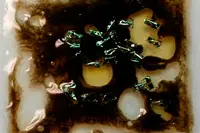 University of Illinois researchers have developed heat-triggered self-destructing electronic devices, a step toward reducing electronic waste and boosting sustainability in device manufacturing.
University of Illinois researchers have developed heat-triggered self-destructing electronic devices, a step toward reducing electronic waste and boosting sustainability in device manufacturing.
The researchers, led by aerospace engineering professor Scott White, published their work in the journal Advanced Materials.
"We have demonstrated electronics that are there when you need them and gone when you don't need them anymore," Prof White said. "This is a way of creating sustainability in the materials that are used in modern-day electronics. This was our first attempt to use an environmental stimulus to trigger destruction."
Prof White's group teamed up with John Rogers, a materials science and engineering specialist at Illinois. Rogers' group has pioneered transient devices that dissolve in water, with applications for biomedical implants.
Describing the goal of the research, Prof White said: "If you can't keep using something, whether it's obsolete or just doesn't work anymore, we'd like to be able to bring it back to the building blocks of the material so you can recycle them when you're done, or if you can't recycle it, have it dissolve away and not sit around in landfills."
The heat-triggered devices use magnesium circuits printed on thin, flexible materials. The researchers trap microscopic droplets of a weak acid in wax and coat the devices with the wax. When the devices are heated, the wax melts, releasing the acid which dissolves the device completely.
The team also developed a radio-controlled trigger that could activate self-destruction remotely on demand. To trigger the reaction, an RF receiver and an inductive heating coil were embedded in the device. The user can send a signal to cause the coil to heat up, which melts the wax and dissolves the device.
The researchers can control how fast the device degrades by tuning the thickness of the wax, the concentration of the acid and the temperature. They can design a device to self-destruct as quickly as 20s after heat is applied.
The devices also can be designed to degrade in steps by encasing different parts in waxes with different melting temperatures. This gives more precise control over which parts of a device are operative, creating possibilities for sophisticated devices that can sense something in the environment and respond to it.
Watch the video showing the researchers describing self-destructing electronics.
Author
Tom Austin-Morgan
Source: www.newelectronics.co.uk

